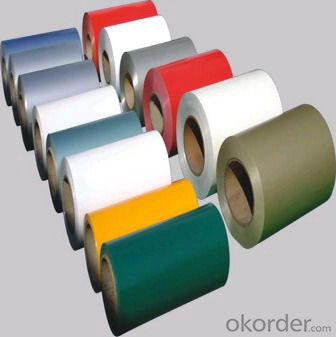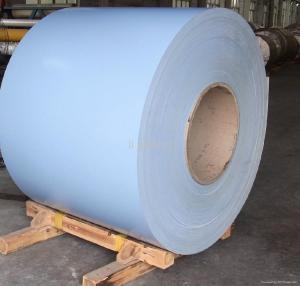RAL 1032 PE 18 Micros Coated Aluminium Coil
- Loading Port:
- Shanghai
- Payment Terms:
- TT OR LC
- Min Order Qty:
- 2 m.t.
- Supply Capability:
- 50000 m.t./month
OKorder Service Pledge
OKorder Financial Service
You Might Also Like
Item specifice
Description
Product | RAL 1032 PE 18 Micros Coated Aluminium Coil | ||
Alloy | 1100, 1145, 1050, 1060, 1070, 3003, 3013, 3005, 3A21,4343,4045, 5052, 5082, 5083, 5086,6061, 8011 etc. | Temper | H12.H14.H16.H18.H22. H24.H26.H32.H34.H36. H38.O etc. |
Thickness | 0.2-7.0mm | Width | Until 2550 |
Painting items | PE and PVDF | Color | All Standards of RAL |
Coil weight | At clients’ requestments | MOQ | 5 tons |
Payment terms | 30% down payment 70% against B/L copy, L/C at sight | ||
Delivery time | 20-30 days after getting your down payment | ||
Package | Wooden Pallet (Customized packing ways are welcomed) | ||
Remarks | The special dimensions can be produced according to clients’ specification | ||


Application
Widely used in manufacturing of products as well as other industrial applications like:
Products Materials: PP cap stock, the traffic sign, air-conditioner heat and exchangers, food container, household foil, pharmaceutical packing, cigarettes packing etc.
Building Materials: aluminum curtain wall base plate, ACP, aluminum, ceilings, aluminum sheets, honeycomb panels and aluminum roofing, lighting decoration, household electrical appliances, food package (such as pop can cover & ring-pull), furniture ect.
FAQ
--Q: Do you provide free samples?
--A: Yes, free samples will be sent to you on freight at destination.
--Q: Can I get your latest products catalogue?
--A: Yes, it will be sent to you in no time.
--Q: What is the MOQ?
--A: 2 tons
--Q: What are your payment terms?
--A: We accept L/C, T/T.
- Q:And what are the advantages/disadvantages of steel aluminum in building cars?Which would be better for building cars?
- Erm im no expert, bt I dont think aluminum is very strong, thus not very safe for a car!
- Q:What are the potential applications of perforated aluminum coils?
- Due to their unique characteristics and versatility, perforated aluminum coils have the potential for a wide range of applications. Here are some of the possible uses of these coils: 1. In architectural projects, perforated aluminum coils can be employed for facades, sunscreens, and cladding systems. The perforations not only create visually pleasing designs but also provide ventilation and sun control. 2. The perforated holes in aluminum coils make them suitable for use as filters in various applications, such as air, liquid, or gas filtration systems. They effectively remove contaminants while maintaining an efficient flow. 3. Perforated aluminum coils can be integrated into industrial equipment like heat exchangers, condensers, and evaporators. The perforations aid in heat transfer, contributing to efficient cooling or heating processes. 4. The automotive industry can benefit from the lightweight and durable nature of perforated aluminum coils. They can be utilized in the manufacturing of automobile parts, including grilles, radiator covers, and engine components, providing both functionality and aesthetic appeal. 5. Aluminum coils with perforations can assist in sound absorption and noise reduction, making them suitable for the construction of acoustic panels in auditoriums, theaters, recording studios, and other spaces where sound quality is important. 6. Perforated aluminum coils can be used for decorative purposes in interior design projects. They can be shaped into screens, room dividers, or wall panels, adding visually appealing patterns and a touch of modernity to spaces. 7. In the agricultural sector, perforated aluminum coils can find applications in crop protection systems. They allow for controlled air circulation while protecting plants from pests or excessive sunlight. 8. The perforations in aluminum coils can be advantageous for energy-efficient applications. They can be incorporated into solar panels, allowing light to pass through while maintaining structural integrity. In summary, perforated aluminum coils have a wide range of potential applications in architecture, filtration, industrial equipment, automotive, acoustic panels, decoration, agriculture, and energy-efficient solutions. Their versatility, lightweight, durability, and aesthetic appeal make them a popular choice for various uses across different industries.
- Q:which metal is very common today and which one will be most common in future. steel or aluminum
- Currently, steel is very cheap but bulky and lacks variability. Aluminum is a lot more expensive, is lighter (cheaper transport), and has variability in use. For the future, however, we would start to use nanoribbon. Substantially smaller than a strand of hair and substantially stronger than steel.
- Q:Can aluminum coils be used in the production of heat exchangers?
- Yes, aluminum coils can be used in the production of heat exchangers. Aluminum is a commonly used material in heat exchangers due to its excellent thermal conductivity, lightweight nature, and corrosion resistance. The use of aluminum coils allows for efficient heat transfer and helps in optimizing the overall performance of the heat exchanger.
- Q:How are aluminum coils cut to length?
- Aluminum coils are typically cut to length using a process known as shearing or slitting. Shearing involves using a set of sharp blades to cut the coil into multiple shorter lengths. This method is commonly used for thicker aluminum coils. Slitting, on the other hand, is a process in which the coil is passed through a set of rotating circular knives that cut the coil into narrower strips of the desired width. This method is often used for thinner aluminum coils. Both shearing and slitting processes can be manual or automated, depending on the scale of production and the specific requirements of the project. Automated cutting machines are commonly used for large-scale production as they offer higher precision and faster cutting speeds. It is important to note that during the cutting process, the coil is often uncoiled and fed through the cutting machine. Once the desired length or width is achieved, the cut aluminum pieces are then collected, bundled, and prepared for further processing or distribution.
- Q:Are aluminum coils suitable for outdoor signage and displays?
- Yes, aluminum coils are suitable for outdoor signage and displays. Aluminum is a highly durable and weather-resistant material, making it an excellent choice for outdoor applications. It is known for its ability to withstand extreme temperature variations, UV rays, moisture, and corrosion. Aluminum coils are lightweight, yet strong, which makes them easy to handle and install. They are also versatile and can be easily shaped and formed into various sizes and designs. In addition, aluminum has excellent printability, allowing for vibrant and long-lasting graphics. Overall, aluminum coils provide a reliable and cost-effective solution for outdoor signage and displays.
- Q:How to purchase PE polyester coated aluminum sheet and PVDF fluorocarbon coated aluminum coil?
- Both belong to color coated aluminum sheet and coil. Customers can purchase ordinary aluminum sheet or coil, and then go to special coating company to add PE polyester coating or PVDF fluorocarbon coating. The color is bright and quality is also very good. PE polyester coated aluminum and PVDF fluorocarbon coated aluminum coil has a wide range of usages: construction industry (aluminum-plastic panel, aluminum honeycomb, roof corrugated sheet, fireproof veneer, aluminum ceiling, shutter, rolling shutter door, garage door, awning, water gutter), electronic appliances (computer chassis, computer panel), lighting, furniture, solar reflector, air conditioning duct and the like. At present it is still applied in many areas including electronic appliance, instrument, lighting, packaging and house decoration.
- Q:In my line of work I see aluminum ground lugs, bonding nuts and straps and also neutral bars eat copper up, especially when exposed to the elements. I know how galvanic reaction works between elements under current load, but my question is why do aluminum and copper seem to hate each other more than any other? And, why would they still be required in usage together per NEC code?
- This problem arises between various metals such as iron aluminium where some form of plastic barrier is needed to stop electrochemical reaction taking place where these metals are in long term contact with each other especially in a wet environment. As far as aluminium copper are concerned, the difference in their chemical reactivity is particularly large; aluminium is a highly reactive metal that quickly becomes dull by coating itself with a very thin layer of aluminium oxide whilst copper is one of the least reactive of all metals. However, once covered with a fine layer of aluminium oxide, aluminium will tend not to corrode further. The effect of this is that any copper that does go into solution as a result of contact with weak atmospheric acids will very readily precipitate again as metallic copper onto the aluminium. Reactions similar to those below will readily take place: H2O (rain) + CO2 --- H2CO3 (carbonic acid - carbon dioxide dissolved in rain water) Cu + H2CO3 --- CuCO3 + H2 In an aqueous environment, 3 CuCO3 + 2 Al --- Al2(CO3)3 + 3 Cu Copper aluminium are regularly used because they are relatively low cost when compared with potential alternatives, even with recent commodity price increases. Toughened plastic has replaced copper in certain plumbing applications which have obviously eliminated this galvanic reaction problem.
- Q:I would like to know why the ionic substance aluminium oxide doesn't dissolve in water.
- Aluminium gives away 3 electrons, and two aluminium atoms are combined with 3 oxygen atoms, the charge is just to great for it to gracefully dissolve.
- Q:how tall is a crushed aluminium soda can compared to a non crushed one.i need measurements in centimeters please.ALSO!! AN IMAGE that actually has both of the two with the measurements would be SUPER HELPFUL
- I don't understand why you can't just measure a can, then crush it and measure it again. And with the number of cellphones kids have today, every one can take a picture. Why do we need to do this for you?
1. Manufacturer Overview |
|
|---|---|
| Location | |
| Year Established | |
| Annual Output Value | |
| Main Markets | |
| Company Certifications | |
2. Manufacturer Certificates |
|
|---|---|
| a) Certification Name | |
| Range | |
| Reference | |
| Validity Period | |
3. Manufacturer Capability |
|
|---|---|
| a)Trade Capacity | |
| Nearest Port | |
| Export Percentage | |
| No.of Employees in Trade Department | |
| Language Spoken: | |
| b)Factory Information | |
| Factory Size: | |
| No. of Production Lines | |
| Contract Manufacturing | |
| Product Price Range | |
Send your message to us
RAL 1032 PE 18 Micros Coated Aluminium Coil
- Loading Port:
- Shanghai
- Payment Terms:
- TT OR LC
- Min Order Qty:
- 2 m.t.
- Supply Capability:
- 50000 m.t./month
OKorder Service Pledge
OKorder Financial Service
Similar products
New products
Hot products
Related keywords





























